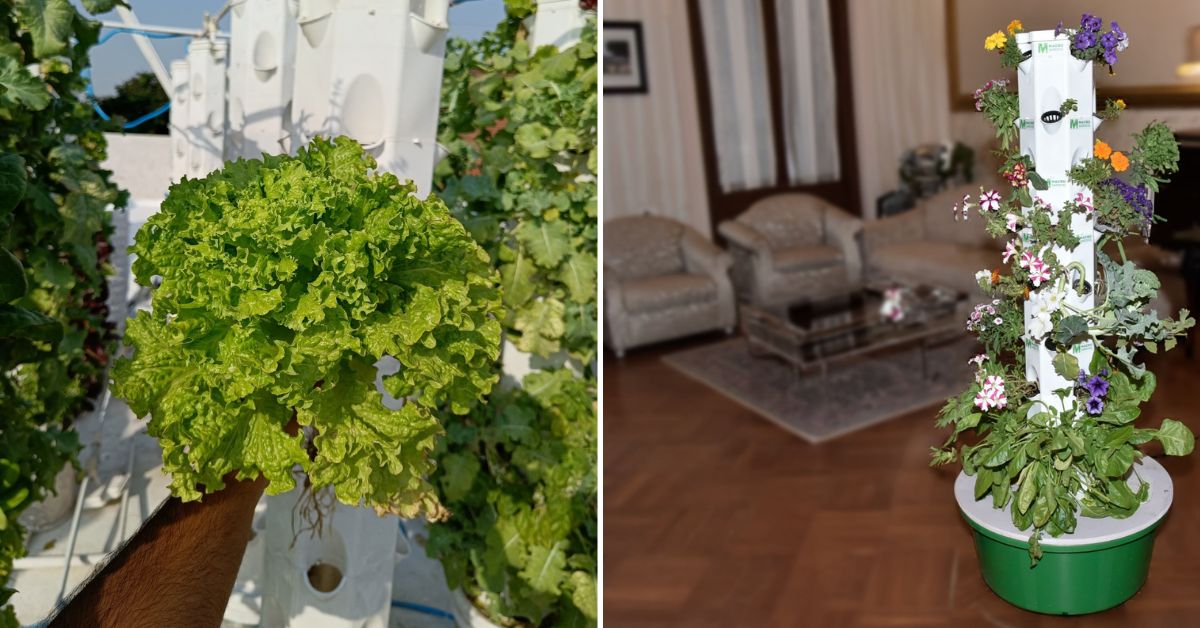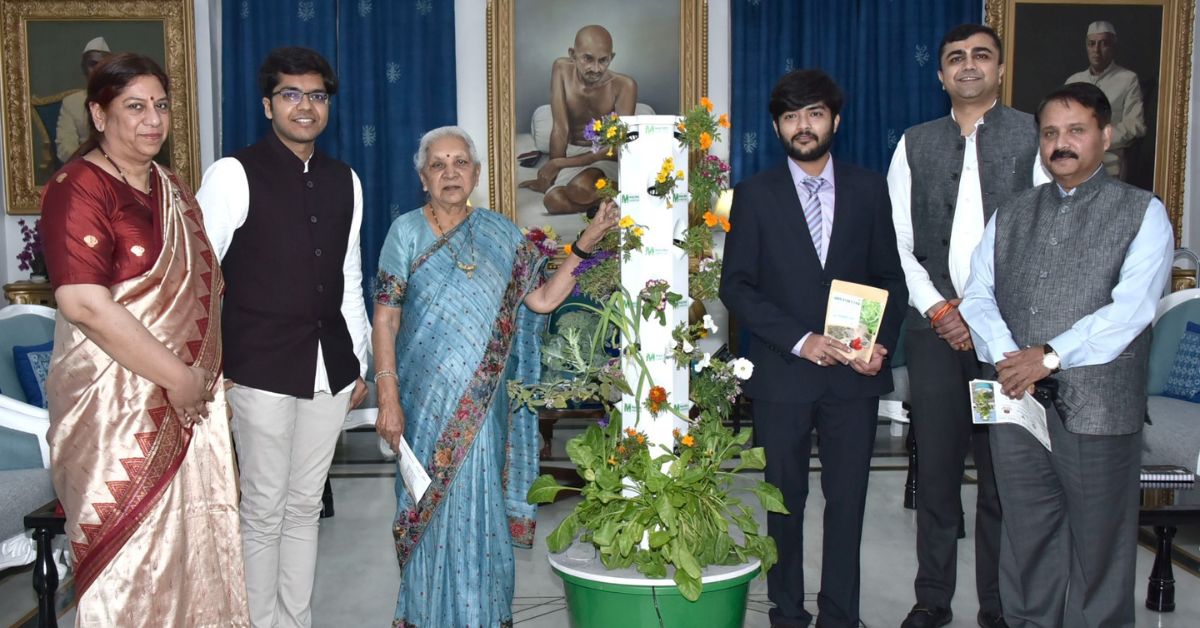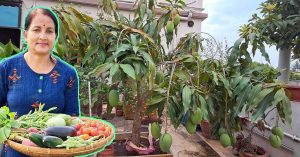These Aeroponic Towers Let You Grow 30X More Vegetables in Small Balconies
Prakhar Agarwal and Tanay Tiwari's IIT Kanpur incubated startup, Macrogardens makes aeroponic towers that let you grow 30 times more vegetables in small balconies.

Delhi’s Abhishek Gupta has set up a kitchen garden to save his family from consuming pesticide-laden vegetables from the market. Recently, he included a unique aeroponic tower in his kitchen garden that grows 32 plants in an area that previously allowed the growth of only two plants.
“This tower occupies as much space as a person takes while standing. And in this small space, I am growing several plants like ladyfingers and lettuce. I harvest lettuce for my salad every single day! Next, I am planning to grow bell peppers,” Abhishek tells The Better India.
“This vertical tower is also low on maintenance. I just have to add nutrients once in 7 to 10 days. I am so happy with this product that I am planning to purchase two more such towers,” adds the software engineer.
Aeroponics is a subset of the soil-less hydroponic method. In this method, the roots of the plants are suspended in the air and irrigated with a nutrient-dense mist. Taking this concept into consideration, Lucknow-based Prakhar Agarwal and Tanay Tiwari developed a unique vertical tower to grow veggies in small spaces, suitable for small apartment balconies in large cities.

In conversation with The Better India, Prakhar explains how the aeroponic tower can revolutionise farming in cities.
Meant for balconies
Prakhar, a computer science graduate by education, was always passionate about growing his own vegetables. Other than ornamental plants, he wanted to grow veggies on his balcony but without opting for a tedious soil-based system.
“This is when I came across the soilless hydroponic and aeroponic systems. While hydroponics requires a horizontal system using PVC pipes that end up taking up a lot of space, I wanted a small setup suitable for a balcony,” says the 25-year-old.
When the school friends Prakhar and Tanay were researching more on the aeroponic system, an incident compelled them to fuel the process. “Once, I drank sugarcane juice from a street vendor and fell sick. It was so bad that I was sick for nearly four months. I knew it was high time that we grow our own food at home,” he says.

In 2020, Prakhar started working on designing an aeroponic tower along with Tanay, and together, they launched ‘Macrogardens’ – an IIT Kanpur incubated startup.
“As we wanted to optimise space, we wanted to develop something vertical unlike a horizontal PVC pipe hydroponic setup,” he says adding that finally, after working on at least 20 designs, the friends came up with an aeroponic tower that was suitable for balconies in small apartments.
Helps grow 30 times more food
Using food-grade plastic, Prakhar and Tanay developed an aeroponic tower with 32 modules. “Apartments, especially in cities like Bangalore and Delhi, do not have enough space for gardening. It allows you to keep very few plants. But with aeroponic towers, anyone can grow 30 times more produce at a 20 percent faster rate compared to a soil-based setup,” he says.
Giving an example, the engineer explains, “One would require a space of four square feet to grow two cauliflowers. But one can grow 64 cauliflowers in the same area using aeroponic towers. We have given 32 pods in one tower that allows the growth of two saplings in each pod.”

“Also, usually people worry about their plants withering away when they have to leave for vacation or on a work trip. They are dependent on their neighbours to water their plants. But our system resolves that issue as well,” he adds.
Prakhar informs that their aeroponic tower automatically sprays water on plants using a motor and a water tank that can store 65 litres of water. “With this, plants can survive for 20 to 30 days without any maintenance. And the power costs only Rs 35 to Rs 40 for a month,” he adds.
Additionally, he claims that the aeroponic tower saves up to 95 percent water compared to a soil-based system where water is lost to transpiration, evaporation, and a large surface area.
Interestingly, the aeroponic system — meant for urban residents and small-landholding farmers — allows one to grow a variety of vegetables from green leafy spinach and lettuce to tomatoes, lady fingers, cucumbers, and even tubers like radish and potatoes.
Making cultivating food easy
The aeroponic tower is priced at Rs 6,500. Along with it, Prakhar also offers seeds, cocopeat as media, and 17 kinds of nutrient mix comprising nitrogen, phosphorus, potassium, iron, and trace elements like manganese, molybdenum, and zinc.

“The only thing that users need to keep in mind is adding the nutrient to the water supply every 12 to 15 days in summer and every 25 days in winter. With our system, you also do not need to keep checking TDS and pH levels in the water. Our main purpose is to show people the ease of growing food at home,” he says.
With this, Prakhar aims to see a behavioural change among urban residents. “Food cooked using freshly harvested produce is better in its texture and flavour. Whenever I harvest kakdi (cucumber), my mother finds it juicy and soft. But generally, by the time vegetables from outside reach our plate, they lose their freshness and nutrients.”
“A large number of people want to grow their food, but with a rising population and decreasing farmland, aeroponics seems to be the future of farming. I wish for every city dweller to grow their own pesticide-free food with this system,” he adds. If you found our stories insightful, informative, or even just enjoyable, we invite you to consider making a voluntary payment to support the work we do at The Better India. Your contribution helps us continue producing quality content that educates, inspires, and drives positive change. Choose one of the payment options below for your contribution- By paying for the stories you value, you directly contribute to sustaining our efforts focused on making a difference in the world. Together, let’s ensure that impactful stories continue to be told and shared, enriching lives and communities alike. Thank you for your support. Here are some frequently asked questions you might find helpful to know why you are contributing?

Edited by Pranita Bhat. All photos: Prakhar Agarwal.
This story made me
-
97
-
121
-
89
-
167













